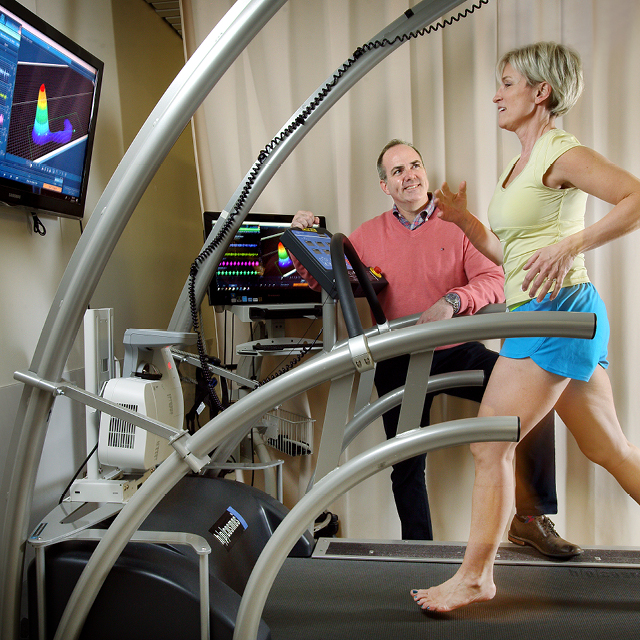
May 14, 2018
Restore Spring 2018

As recreational running has grown in the U.S., the practice for treating injured amateur runners with physical therapy has stayed roughly the same. But seven years ago, the Johns Hopkins Rehabilitation Network started the Johns Hopkins Running Program to offer all runners the same advanced technology and resources that were once only available to elite and professional athletes. Today, these services—which aim not only to facilitate healing but also to avoid future injuries—are available to runners at various Johns Hopkins facilities in Maryland.
The program is a collaboration between physical therapists, physiatrists, sports medicine physicians and orthopaedic surgeons. Experts include sports medicine internist Sameer Dixit and new sports medicine physiatrist Mark Ellen, who specializes in the nonoperative treatment of strains, sprains, tears, bursitis, tendinitis and more.
“Much of the technology we use was previously only provided at university gait labs to professional athletes due to its cost,” explains Ken Johnson, physical therapist and director of ambulatory rehabilitation therapy services at the Johns Hopkins Rehabilitation Network. “With market competition increasing and the cost for technology decreasing, we’ve been able to offer this extremely sophisticated analysis to the general patient population.”
This new equipment includes an instrumented treadmill equipped with more than 7,000 sensors in the deck for initial and progress evaluations. While patients run, these sensors and special LED sensors worn on the body capture hundreds of data points on variables including cadence, stride length and impact stress. The treadmill also has cameras for high-speed motion analysis that record at a rate of 100 frames per second, allowing clinicians to examine minute changes in body position and impact stress that can have a significant influence on how muscles are activated and recruited.
Patients also benefit from hand-held devices that measure strength, Johnson says. While traditional assessments rely on a therapist’s skill to assess strength and gauge the extent of imbalances, studies have shown that even the most experienced clinicians can miss strength imbalances as great as 30 percent between different sides of the body. Tools such as the ones Johnson and other therapists use in the running program offer a truly objective measurement.
While patients are recovering, another technology allows them to ease back into running with a lower level of impact and strain. Johnson and his colleagues often have them run for a few sessions on an anti-gravity treadmill as they recover, instead of running at full impact right away. The treadmill supports as much as 40 to 50 percent of their body weight.
New treatment techniques also help speed healing, Johnson adds. Clinicians in the program use instrument assisted soft tissue mobilization with special tools that are contoured to every body shape, and machines that apply negative pressure to improve blood flow, decongest swelling and reduce scar tissue. Additionally, a device that delivers low energy myoacoustic pressure waves helps strengthen the resiliency of bones and joints, and the mobility of fascia, muscle and tendon, helping to improve exercise ability over time.
Together, Johnson says, these tools—combined with feedback from the treadmills and an evidence-based exercise program—are helping to get injured runners off the couch and back on the road. “For me,” he says, “there’s no greater feeling than to receive a call or an email from a patient saying that they’ve returned to running injury-free, are setting personal best times, and that they couldn’t have done it without us.”

